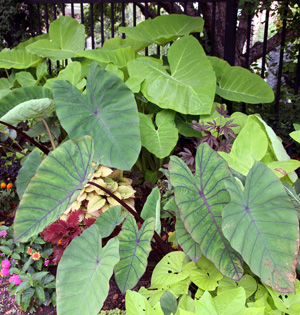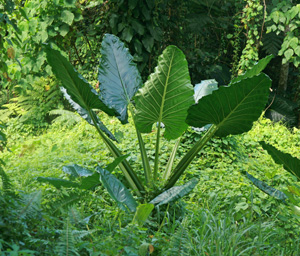
 1
1








Idle dreamer




 1
1




Big Island, Hawaii, 2,000 ft elevation, 200+ inches yearly rainfall.
Ua Mau Ke Ea O Ka Aina I Ka Pono




 1
1




 1
1




 1
1




Eugene Holmes wrote:Have been getting great information on growing colocasia esculenta (different varieties) also the American equivalent Xanthosoma Sagittifolium on a Youtube channel called, Compostapr.
It is in Spanish but the guy is really very knowledgeable! The variety "Elena" has lilac flesh and is very edible 😋. That is available at Wellspring Gardens. Also the regular green leaf with the white flesh tuber.
Taro does not make separate corms like the Xanthosoma. One must remove all young suckers or the plant will not grow a sizeable one to eat.
There is a variety of colocasia that the tuber is called eddo in some of the English speaking Caribbean Islands. This one does produce runners with small (tennis ball size) tubers. Those can be found in many Asian or Puertorican produce markets as well. Hope this helps.
 1
1




 , who works with it, and asked him.
, who works with it, and asked him.
 2
2




William Bronson wrote:This thread reminded me of an idea I was pursuing.
I live in zone 6, so most of these varities would not over winter here.
There is one that is known to be hardy and thats Chuna Pink.
I wasn't sure if it was a Colocasia esculenta or one of the other things that look like Colocasia esculenta.
I found a breeder, Brian at Brian's Botanicals
, who works with it, and asked him.
He confirmed the identity.
This doesn't mean China Pink is "edible" , more like it confirming its is "tomato" not a "potato" I.E. potatoes and tomatoes are closely related and they both have fruit, but you wouldn't want to eat potato berries at all, but most varieties of tomatoes have the same things in their fruits.
All said, this is enough for me to want to grow China Pink.
It will be there if I needed it, hidden in plain sight.
 1
1












William Bronson wrote:This thread reminded me of an idea I was pursuing.
I live in zone 6, so most of these varities would not over winter here.
There is one that is known to be hardy and thats Chuna Pink.
I wasn't sure if it was a Colocasia esculenta or one of the other things that look like Colocasia esculenta.
I found a breeder, Brian at Brian's Botanicals
, who works with it, and asked him.
He confirmed the identity.
This doesn't mean China Pink is "edible" , more like it confirming its is "tomato" not a "potato" I.E. potatoes and tomatoes are closely related and they both have fruit, but you wouldn't want to eat potato berries at all, but most varieties of tomatoes have the same things in their fruits.
All said, this is enough for me to want to grow China Pink.
It will be there if I needed it, hidden in plain sight.
Iterations are fine, we don't have to be perfect
My 2nd Location:Florida HardinessZone:10 AHS:10 GDD:8500 Rainfall:2in/mth winter, 8in/mth summer, Soil:Sand pH8 Flat




William Bronson wrote:This thread reminded me of an idea I was pursuing.
I live in zone 6, so most of these varities would not over winter here.
There is one that is known to be hardy and thats Chuna Pink.
I wasn't sure if it was a Colocasia esculenta or one of the other things that look like Colocasia esculenta.
I found a breeder, Brian at Brian's Botanicals
, who works with it, and asked him.
He confirmed the identity.
This doesn't mean China Pink is "edible" , more like it confirming its is "tomato" not a "potato" I.E. potatoes and tomatoes are closely related and they both have fruit, but you wouldn't want to eat potato berries at all, but most varieties of tomatoes have the same things in their fruits.
All said, this is enough for me to want to grow China Pink.
It will be there if I needed it, hidden in plain sight.
 2
2














Taro can be distinguished from elephant ears by the attachment of the leaf from the petiole. In taro, the petiole attaches to the leaf several inches from the base of the ‘V’ of the leaf, while the petiole is attached directly at the base in elephant ears. The leaves are light green for elephant ear and darker green in color for taro.
 1
1




 2
2




Mandrake...takes on and holds the influence
of the devil more than other herbs because of its similarity
to a human. Whence, also, a person’s desires, whether good
or evil, are stirred up through it...
-Hildegard of Bingen, Physica

|
That's a very big dog. I think I want to go home now and hug this tiny ad:
rocket mass heater risers: materials and design eBook
https://permies.com/w/risers-ebook
|


